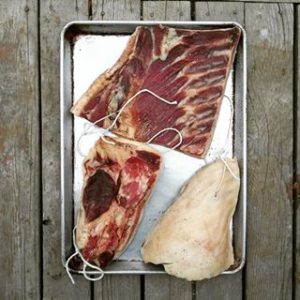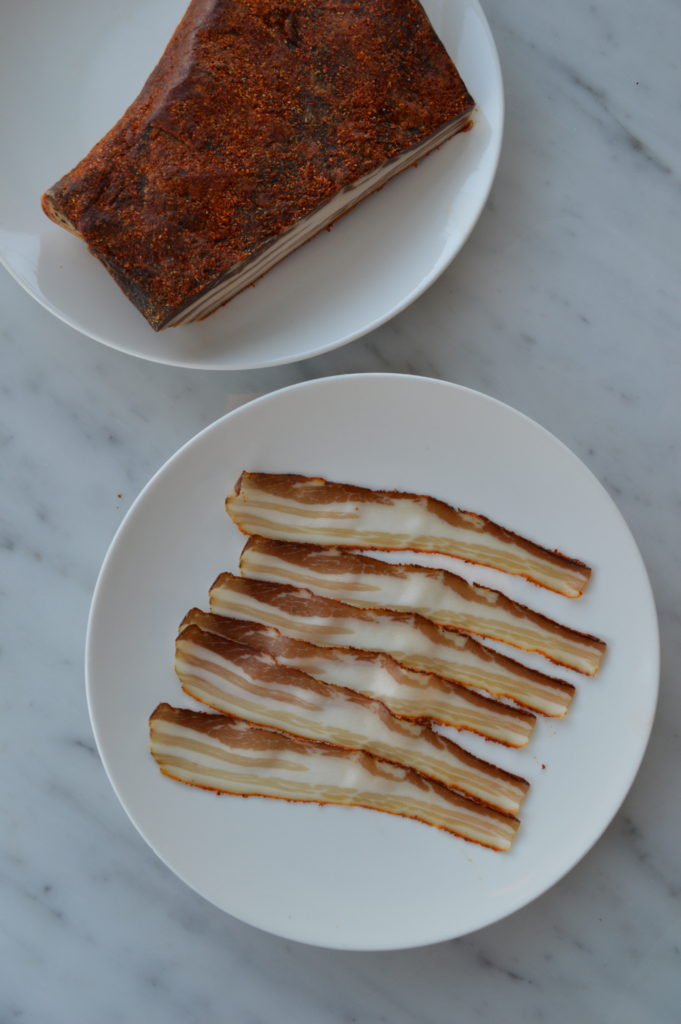Originally published May 31, 2010! Holy smokes. Re-published today to include more info and some nicer photos.

Pancetta is Italian for “little belly.” The term refers to pork belly that has been cured and at least partly air-dried. Unlike North American bacon it is usually not smoked. It is a very important ingredient and foundational flavour in many Italian cuisines.
While North American bacon tends to use a simple salt and sugar cure, Italian pancetta is often redolent with flavours like juniper, nutmeg, and herbs.
Plus it is made in three distinct shapes. Pancetta tesa is a flat slab of pork belly, like bacon. Pancetta arrotolata has the belly rolled over the long axis, giving the sliced meat a delightful, spiral cross-section.[1] For pancetta steccata the belly is folded once over the short axis and then bound and pressed in a manner similar to soppressata. I have never made steccata but there is a great description of the process here. One important detail is that while most Italian whole-muscle salumi can be made without curing salt, the arrotolata and steccata should include nitrite.[2] The logic is that in these preparations there is an exterior surface being put into an anaerobic environment, as with salami.
Here are my two favourite formulae for pancetta:
Pancetta
adapted from Charcuterie by Ruhlman and PolcynIngredients
- 100% pork belly
- 3% kosher salt
- For pancetta arrotolata or pancetta steccata: 0.267% curing salt
- 0.400% black pepper, coarsely ground
- 1.110% brown sugar
- 0.440% juniper berry, coarsely ground
- 0.670% fresh garlic, coarsely chopped
- 0.040% bay leave, crumbled
Pancetta Calabrese
As far as I know, this isn’t a traditional version of the pancetta made in Calabria; I just call it that because it’s crusted with Calabrian chilis.
Ingredients
- 100% pork belly
- 3% kosher salt
- For pancetta arrotolata or pancetta steccata: 0.267% curing salt
- 0.750% fresh garlic, coarsely chopped
- 0.400% black pepper, coarsely ground
- 0.165% quality dried oregano
- 1.175% ground Calabrian chilis (These are rubbed onto the belly after it has been cured, rinsed, and patted dry. The make a very distinctive red crust on the exterior as the meat air-dries.)
Curing Pancetta
The curing process is very standard. Rub the cure mix onto the belly. Place the belly in a non-reactive container or large resealable bag. Refrigerate for at least one week. Every couple of days, take the belly out and redistribute the cure by giving the pork belly a little massage. This is called overhauling.
After about one week, the belly will be firm to the touch. Rinse off the seasoning and dry the meat thoroughly. You are ready to air-dry your pork!
How to Hang Pancetta Tesa
For flat pancetta tesa I have a large metal skewer intended for barbecue shish kebabs that I use to thread a piece of twine through the meat.
How to Roll and Tie Pancetta Arrotolata
Here’s our belly after the cure:
Roll across the long axis and tie a single slipknot in the middle to keep the belly rolled. The tightening and cinching ability of a slipknot is essential here. A simple square knot will loosen as soon as it is tied.
Work from the middle out I tie another slipknot roughly every inch across the length of the roll.
For good measure, I tie a knot between each of the other knots, so there is one loop every half inch.
Air-Drying Pancetta
One of the reasons we make pancetta in my More Charcuterie at Home class is that it is a relatively forgiving cut to air-dry, even without a full-blown temperature- and humidity-controlled curing chamber.
Ideal conditions are between 8°C and 15°C, and between 60% and 80% humidity. However in Charcuterie Michael Ruhlman says that he hangs his pancetta in his kitchen, with his pots and pans. I think because of the high fat content, and the relatively flat shape and quick drying, you have a lot more wiggle room with temperature and humidity than you would with, say, prosciutto or wide-diameter salami.
I don’t have a proper curing chamber at home, but I live in an old house with a very cool basement (cool temperature-wise, not style-wise). In fact, if I close the heating vents in one room, there is a large cupboard built into the wall that never gets above 15°C between October and March. This is where I air-dry my cured meat. At first I ran a small humidifier in the adjacent room but found that it didn’t seem to make much of a difference.
Pancetta tesa I typically hang for two weeks.
Pancetta arrotolata I hang for at least four weeks but it can go much longer, especially if you plan to slice and eat raw.


Footnotes
1. At Jack’s Grill c. 2010 chef Ben Chalmers had a dish of asparagus, prawns, and pancetta. The prawns and pancetta had a nearly identical swirl shape, and they were shingled alternating prawn and pancetta slice for emphasis. My hands hurt just thinking about the number of slipknots I tied around rolled pancetta at Jack’s Grill that summer.
2. According to Salumi by Ruhlman and Polycn.